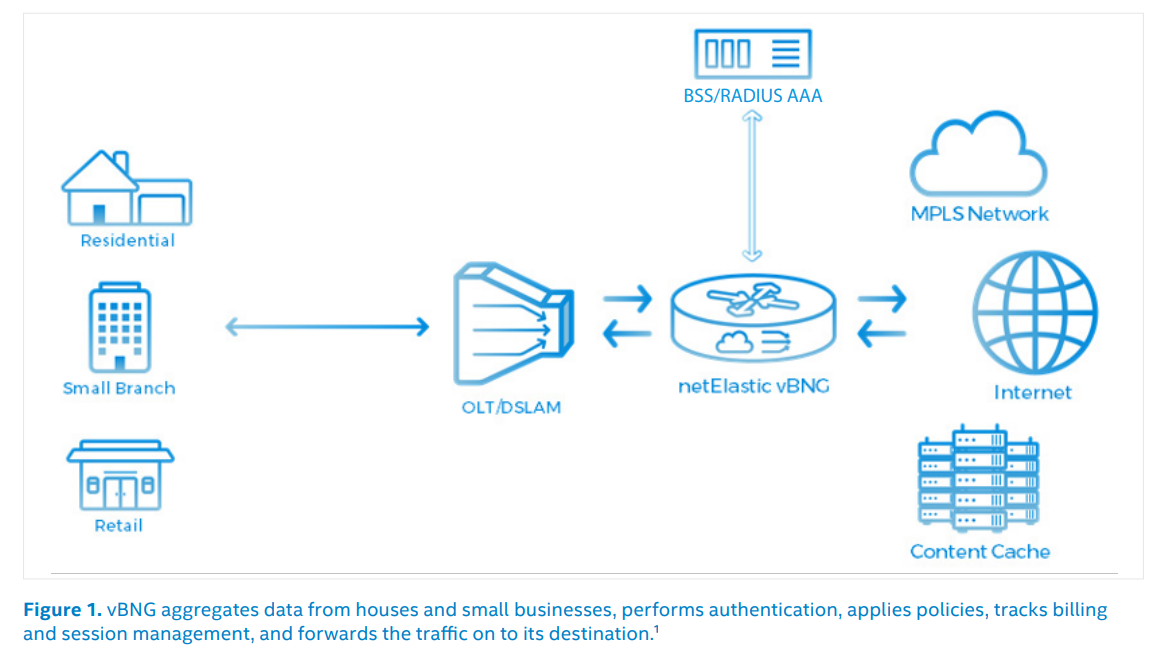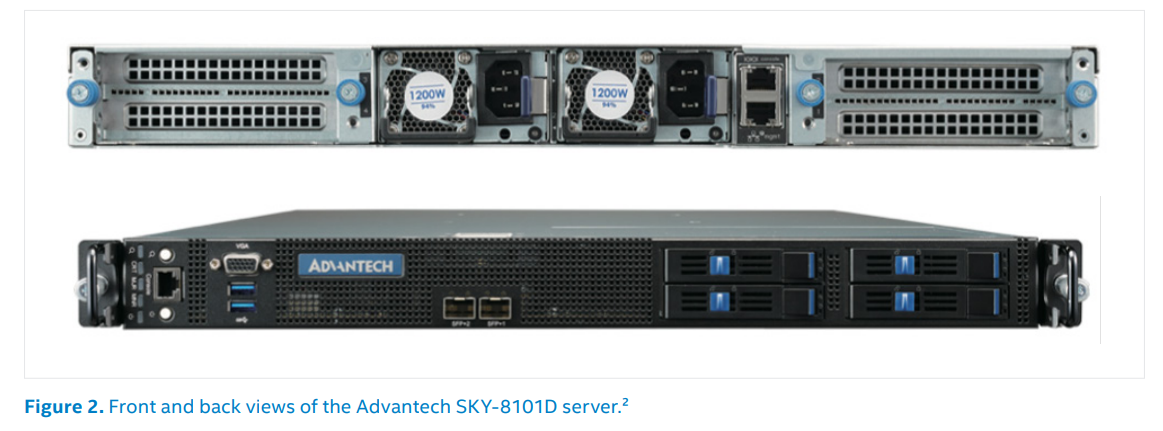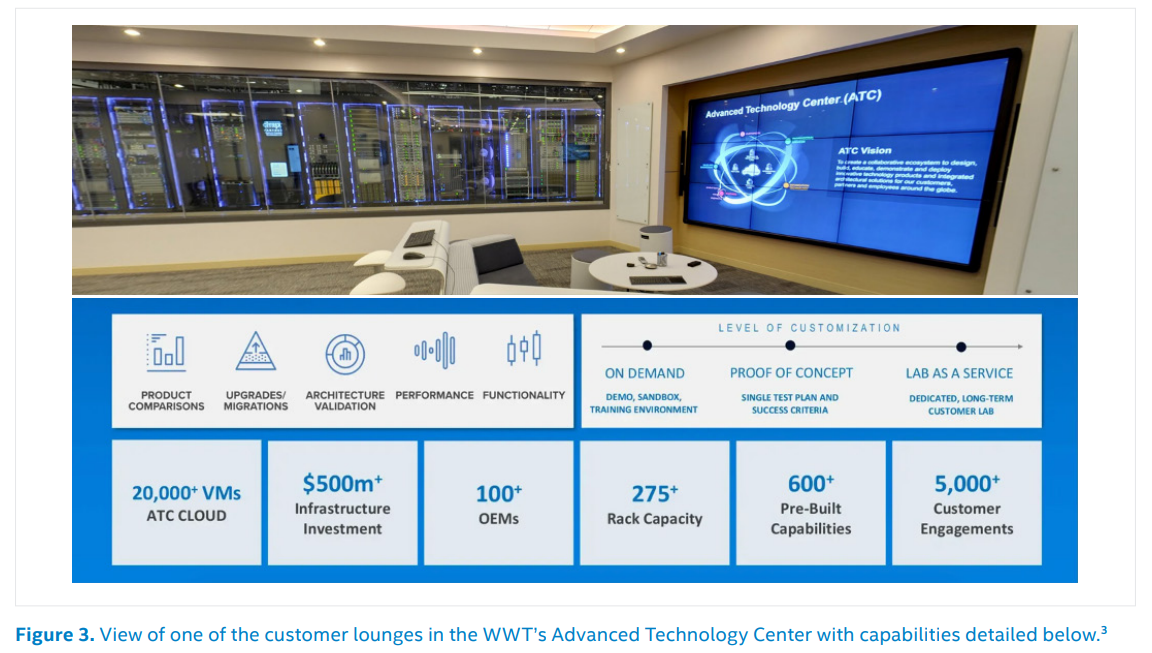WWT Integrates vBNG with Advantech, Intel, and netElastic for 5G
15.12.2020
* This White Paper was originally published by Intel at here.
Virtual broadband network gateways (vBNGs) are key to scaling 5G and broadband networks. Utilizing its Advanced Technology Centers, World Wide Technology integrates vBNGs for communications service providers of all sizes.

Virtual broadband network gateways (vBNGs) are an important part of broadband wired networks, which will be just as important in new 5G networks as they start scaling to support expected high user demand. By processing packets and applying policies at the edge of the network, the vBNG grooms data flows at a very early point in the network. vBNGs need a lot of compute power and benefit from being customized to a communication service provider’s (CommSP) particular network.
World Wide Technology (WWT), an Intel® Network Builders ecosystem partner, has partnered with Advantech, Intel, and netElastic to develop a scalable vBNG solution for a wide range of CommSPs using WWT’s Next-Generation Factory model.
vBNGs Emerge for Growing Broadband Networks
CommSPs are experiencing significant increases in their data traffic, reflecting both the growth in the number of connected devices on the network and new, data-centric services. This increase is impacting fiber to the home (FTTH) networks, and CommSPs are expanding the footprint of their fiber networks and upgrading legacy networks to address the demand.
5G will accelerate both trends as it delivers more bandwidth for video consumption and cloud computing usage by consumers and businesses, and more network connectivity for IoT sensors, automobiles, and other connected devices.
5G promises data throughput in the hundreds of megabits per second range with very low latency. Just as important, 3GPP standards specify support for much higher network density—about 1 million devices per square kilometer (.38 mile) or 50 times greater than 4G, which supports 2,000 devices per square kilometer, according to the 3GPP standard.
5G also offers network slicing, which divides the bandwidth of a 5G connection to allow each partition a different quality of service (QoS) profile to support different applications. Network slicing is initiated at the edge of the network where packets are analyzed and policies of their slice are applied.
Traditionally, broadband network gateways (BNG) are used to manage broadband network access and provision network features, policies, and service levels. BNGs feature flexible support for new policies and help CommSPs deploy new capabilities quickly and affordably, thus realizing potentially greater revenue while helping simplify network design. A vBNG establishes and manages subscriber sessions (see Figure 1). For active sessions, the vBNG will aggregate traffic and route it to the CommSP’s transport network. Some vBNG subscriber access functions include:
- Quality of service (QoS)
- Subscriber session authentication, authorization, and accounting (AAA)
- Address assignment
- Security
- Policy management
After providing the session management and billing functions, the vBNG then routes data traffic to its destination. Before vBNGs, BNGs originated as application-specific servers for DSL networks. These hardware-based broadband network gateways are not built for 5G networks or modern wireline broadband networks that are more dynamic and have higher bandwidth.
vBNG functionality must be able to scale to support fast data and subscriber growth. Advancements in CPU processing power and virtualization technology have made it possible to create vBNGs that can provide the packet throughput, full range of packet processing functions, and the scalability needed to help 5G operators support new applications and grow their networks.
WWT partnered with Advantech, netElastic, and Intel to develop a complete vBNG solution that CommSPs can use to modernize their network architecture in order to facilitate next-generation advanced services. The solution is integrated in WWT’s Advanced Technology Center (ATC), a unique lab environment with more than $500 million in technology infrastructure where CommSPs’ technicians can customize the solution to their exact specifications.

WWT vBNG Solution Blueprint
WWT’s vBNG Solution Blueprint uses netElastic software running on Advantech servers powered by 2nd generation Intel® Xeon® Scalable processors. The netElastic vBNG provides the same services as an appliance-based BNG, including establishing and managing subscriber sessions and providing services such as QoS, AAA, address assignment, security, and policy management. In addition, the software provides:
- Carrier grade network address translation (CG-NAT)
- Support for MPLS/LDP routing
- L2/L3 VPN
vBNGs are located at the edge of the 5G network and must have the packet processing performance to authorize and authenticate users and look up and implement policies on a per-user basis and then to forward those packets from broadband access networks to the backbone network. The netElastic vBNG software utilizes a software-defined networking (SDN) architecture that separates the control plane and data plane functions, which allows each to be run on their own separate hosts or virtual machines. By separating the control plane and data plane, both can be scaled independently, providing maximum deployment flexibility. The netElastic vBNG’s SDN architecture also improves network flexibility and simplifies infrastructure management with software-based control.
WWT selected Advantech SKY-8101D servers (see Figure 2) for these tests to address the vBNG’s need for dataheavy computing. The Advantech SKY-8101D is a verified Intel® Select Solution for NFVI Forwarding Platform system. Advantech has worked closely with Intel to optimize the hardware and software configurations of the SKY-8101D to deliver high performance for virtualized packet-based workloads.
The SKY-8101D is a 1RU, dual-socket server that utilizes non-uniform memory access (NUMA)-balanced architecture to maximize data plane performance for high I/O workloads. The SKY-8101D servers selected for the vBNG application are powered by 2nd generation Intel Xeon Scalable processors because they need the performance and features to provide powerful virtualized networks that create agile and scalable service infrastructures.
The processors can deliver diverse services efficiently because the CPU has features required for application, control, packet, and signal processing. This innovative processor sets a new level of platform convergence and capabilities across compute, storage, memory, network, and security. CommSPs can now drive forward their most ambitious digital initiatives with a feature-rich, highly versatile platform.
The SKY-8101D supports 24 DIMM sockets supporting up to 1,536 GB DDR4 RAM. The SKY-8101D PCIe subsystem offers high-speed I/O expansion with slots for four PCIe x16 Gen3 adapters. The server also features four Intel® Ethernet Network Adapters XXV710, supporting DPDK network acceleration for up to 400 Gbps raw PCIe throughput per system. The system is upgradable to support 100 GbE connections using the Intel® Ethernet Network Adapter E810-CAM2.
The server powers configuration of a netElastic commercial vBNG supporting up to 128,000 users. Configuration of two vBNGs on a server provides double the user count to 256,000 subscribers.
The software foundation of the vBNG solution is based on Red Hat OpenStack and Red Hat Linux for the vBNG Solution Blueprint at WWT. The advanced cloud, network automation, and DevOps capabilities built into Red Hat software enable WWT’s ATC to validate the full-stack of this vBNG solution.
Red Hat is a WWT Advantage Partner and has been a very strong contributor and sponsor of WWT solution blueprints aimed at accelerating CommSPs’ time to market.

The vBNG Solution Blueprint also leverages the open source Data Plane Development Kit (DPDK) for improved virtual switch performance, Intel® solid state drives (Intel® SSDs) for fast access to data storage, and Intel Ethernet Network Adapter XXV710 for connectivity. The network adapter supports single-root input/output virtualization (SR-IOV) that enables multiple virtual network functions (VNFs) to have direct connection to the network card for fast throughput rates.
WWT Services and Support
The last major component of the solution is WWT’s full range of services and support, starting with its Advanced Technology Center (ATC). The ATC (see Figure 3) provides the environment and computing resources for thorough and customized hardware and software integration. The ATC helps WWT work collaboratively with CommSPs to design and integrate solutions before staging them and distributing them to CommSP locations across the globe.
This flow is referred to as WWT’s Next-Generation Factory program, and it helps CommSPs move from innovation to validation and deployment more rapidly by validating complex, multi-vendor solutions with speed and integrating them at scale through one of four integration facilities across the globe (St. Louis, Singapore, Amsterdam, and Mumbai).
The ATC, which is virtually available to customers 24/7, includes four data centers with more than 300 racks of equipment. Customer or partner teams can work on-site or virtually with access to demos, workshops, labs, proofs of concepts, advisory services, and training. WWT also utilizes dedicated racks at an Equinix co-location facility to demonstrate the speed of using an Equinix site and demonstrate management of different platforms required to meet customer business goals. Once validated, WWT can build and install the equipment at Equinix co-location sites.
The ATC offers access to scalable lab resources that allow interaction with customer and partner environments, and allows for collaboration on architectural solutions.
Once the solution is designed and validated, WWT can help CommSPs with supply chain, integration, implementation, and ongoing support services at whatever level they desire all the way up to being a one-stop shop. WWT’s Day 2 Support covers the customer from the day the software arrives in their network and adds a critical element to the “cradle-to-grave” support that WWT can provide to worldwide customers of its WWT Solution Blueprints.

By integrating the vBNG solution, CommSPs are privy to an array of advantages:
- Flexibility and scalability that enable CommSPs to expand easily from a few users to as many as 256,000 when needed, making it easier to accommodate a rush of sudden subscriber density.
- Verified throughput that enables vBNGs equipped with Intel network interface cards (NICs) to accommodate up to 256,000 broadband users—with performance results that are verified in the ATC.
- Cost efficiencies gained by employing inexpensive whitebox services.
- Reduced footprint compared to hardware-based alternatives, with simplified network design choices. As needs increase, more virtual gateways can be easily spun up.
- Greater manageability, thanks to virtualization.
- Next-generation central office–readiness as part of a suite of new telecommunications capabilities that enable service providers to reduce costs and protect CommSPs’ infrastructure investments.

Scalable vBNG System
To demonstrate the scalability of the vBNG Solution Blueprint,⁴ WWT designed it specifically for a densely populated urban area supporting home internet subscribers. The system supported traffic coming from three points of presence with 32,000 subscribers per port and each port running on an Intel Xeon Scalable CPU core inside the SKY8101D. With eight cores dedicated to incoming connections, the vBNG can support 256,000 broadband users.
The routing capability within the netElastic vBNG supports 25,000 OSPF routes per port. The system was configured to work at the network edge and to send data to a regional network or to a data center depending on the traffic type. The system performance comes from a 1U-high server and can scale with the addition of other servers to serve a maximum of 1 million subscribers.
Conclusion
vBNGs offer the ability to build modern networks that scale with 5G network speeds and growth in connectivity. In addition, vBNGs allow easy provisioning of new service policies, data security mandates and service promotions. WWT has partnered with Advantech, Intel, and netElastic to build a very high-performance solution that is customized for each CommSP using the advanced integration capabilities of the ATC.
Learn More
- WWT: https://www.wwt.com
- netElastic Systems: https://netelastic.com
- Advantech Network & Communications: https://www.advantech.com/nc
- Advantech, WWT and NetElastic are members of the Intel® Network Builders program: https://networkbuilders.intel.com
- Intel® Xeon® Scalable Processors: https://intel.com/xeonscalable
Notices & Disclaimers
- ¹Figure provided courtesy of Netelastic.
- ²Figure provided courtesy of Advantech.
- ³Photo and data provided by WWT, November 2020.
- ⁴Testing conducted by WWT in Sept. 2020: Configuration 1 platform was the Advantech SKY-8101D featuring two 24-core Intel Xeon Gold 6252N processors (microcode: 0x5002f01). Intel Hyper-Threading Technology was turned on, Intel® Turbo Boost Technology 2.0 was turned off and power management was set to maximum performance. BIOS version was the Advantech 8101D BIOS 2.16.00. The system featured one Intel 960 GB SSD OS drive and 384 GB of memory. Ethernet connectivity was provided by four Quad-Port 25 Gbps Intel® Ethernet Network Adapters XXV710-DA2. The platform controller hub was an Intel® C620 chipset.
- Performance varies by use, configuration and other factors. Learn more at www.Intel.com/PerformanceIndex. Performance results are based on testing as of dates shown in configurations and may not reflect all publicly available updates. See backup for configuration details. No product or component can be absolutely secure.
- Your costs and results may vary.
- Intel technologies may require enabled hardware, software or service activation.
- Intel does not control or audit third-party data. You should consult other sources to evaluate accuracy.
- © Intel Corporation. Intel, the Intel logo, and other Intel marks are trademarks of Intel Corporation or its subsidiaries. Other names and brands may be claimed as the property of others
.jpg)


